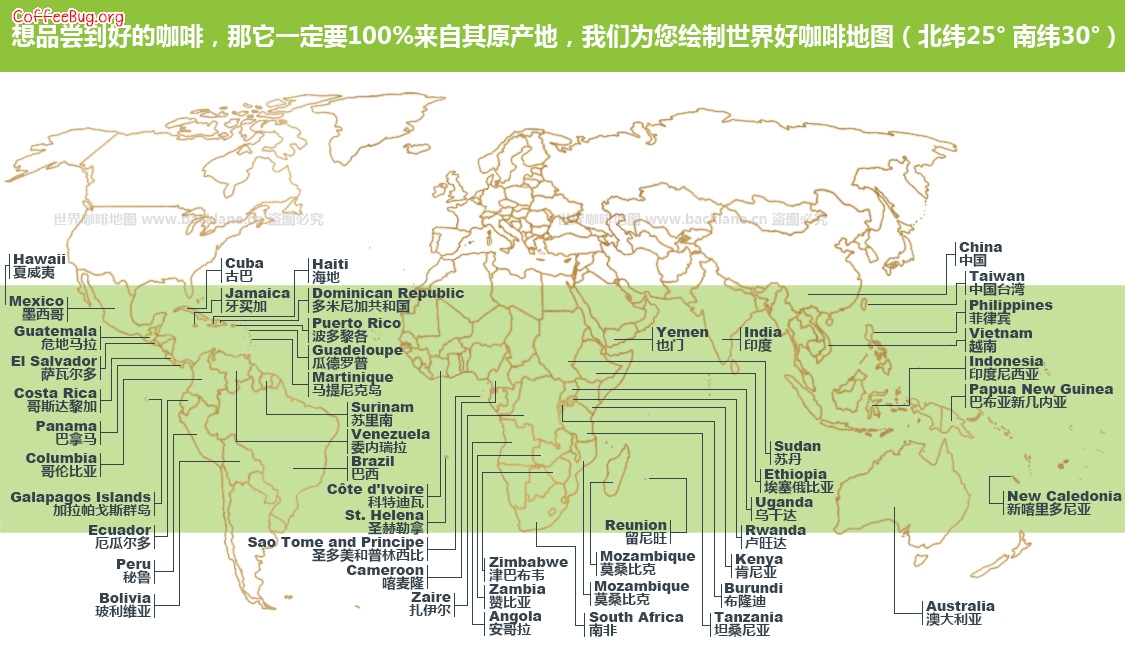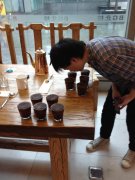Detailed description of the flavor and taste of the world's top boutique coffee bean varieties

Whether it is traditional commercial coffee or fine coffee, the classification of coffee is based on the production area first, followed by the classification of beans by size. The common fine coffee production areas are as follows:
Ethiopia: The original taste of coffee
Annual output: 396,000 tons
"A glass of washed Yirgacheffe can bring out exquisite floral and sweet fruit flavor, which is unparalleled; or sun-treated Sidamo, sweet and atmospheric, are the most classic top representatives of Ethiopian coffee."
Lorenzo Perkins, Director of Education, Cuvée Coffee
Ethiopia is the birthplace of the famous Arabica coffee bean, and the tradition of harvesting wild coffee beans has been maintained to this day. The coffee garden with an altitude of more than 1500 meters has formed a unique coffee terroir after more than a thousand years of evolution and adaptation. Ethiopian coffee grown in natural wild environment is called "wilderness coffee", which retains the most original and natural taste of coffee beans and has the most direct and full expression of terroir.
It is worth mentioning that most of the coffee in Central and South America has been introduced, Ethiopia is a rare native place, and there are countless native wild varieties that have not yet been discovered.
Among Ethiopia's nine major coffee-producing areas, Sidama and Yegashefi are the most outstanding. Yejia Xuefei was originally a sub-production area of Sidamo, which was independent due to its special flavor. The rich and complex fruity flavor made it an international hit almost overnight, making it a sought after object for connoisseurs and expensive.
Kenya: The coffee experience of a lifetime
Annual output: 45,000 tons
"If I could only drink one kind of coffee in the future, I would choose Kenyan coffee."
Dear Coffee, I Love You by Brian Jones
Kenya's coffee history is not long, Arabica varieties began to be introduced in the early twentieth century, and more Bourbon varieties from Brazil were cultivated later. During the early British colonial period, a perfect cultivation and management system was established for Kenya's coffee industry. The cooler temperatures of Kenya's higher elevations lengthen the ripening period of coffee beans, which in turn allow for the accumulation of the fruit's complex aromas. Unrestrained acidity, rich aroma of fruit, such as blackcurrant, grapefruit, etc., constitute the characteristics of Kenya coffee rough maturity.
Kenya pays more attention to the cultivation of coffee varieties. SL28 developed by professional team is a direct branch of bourbon coffee beans and is the best representative of Kenya coffee quality and flavor.
Colombia: The Joy of Exploring Diversity
Annual output: 660,000 tons
"Many small coffee farmers in Colombia grow, harvest and process their beans independently, and there are some refreshing single-lot coffees whose quality reflects the ingenuity of the coffee farmers and the unique terroir in which they live."
--Ryan Knapp, Manager, Madcap Coffee Company
The biggest feature of Colombia coffee is its diversity of styles. If compared with wine, it is like a champagne producing area where big factories and small farmers coexist. It has both standardized stable styles and interesting and changeable small yield stars. Overall, Colombia coffee is fresh and fruity. Colombia coffee producers have a very professional roasting technology to maximize the quality of coffee beans.
Fourth place Guatemala: Surprising upstart
Annual output: 186,000 tons
"Coffee from this small Central American country has been outstanding in recent years: harmonious, sweet, soft, full of aroma, tasting it as if it were exploring its roots (Mayan culture)."
Pure Coffee blogger Bill Walsh
Guatemala coffee with its unique style, in recent years among the world's coffee producing areas. In the cool volcanic zone, coffee beans develop complex aroma layers and full taste, reminiscent of the ancient Mayan culture here, deep and mysterious.
Fifth place (tied) Costa Rica: good mountains, good water, good coffee
Annual output: 84,000 tons
"My love for Costa Rica comes from warm people, beautiful scenery and, of course, amazing coffee."
--Connie Blumhardt, publisher of Roast magazine
Costa Rican coffee beans are mainly Arabica coffee beans, processed by washing, bright in style, mild in acidity and excellent in sweetness. The Costa Rican Coffee Association manages the coffee industry throughout the country and has specialized scientific institutions to discover and improve the quality of indigenous coffee.
Fifth place (tied) Honduras: Pride in troubled times
Annual output: 252,000 tons
"Outstanding Central American origin, two brands located on both sides of the mountain range, showing very different styles. El Cielito's César Fernandez's coffee has fruity aromas of cranberries, raisins and apricots, while San Luis Plane's Mariano Mejía's coffee is more green tea, red gallons and hazelnuts."
--Cafe Grumpy Coffee Purchasing Cheryl Kingan
The turmoil may have made Honduras a seemingly obscure coffee-producing country, but it is one of Central America's leading coffee exporters, second only to Guatemala in terms of exports.
Indonesia: It seems that you can forget cat poop
Annual output: 702,000 tons
"Java and Bali coffee producers focus on cultivating and processing specific varieties of coffee beans, refining the process."
David Buehrer, Greenway Coffee Company
Indonesia has not only the controversial civet, Sumatra's mantinin coffee is rich and mellow, Java coffee is mellow, all of which are well-known classics of Indonesian coffee. Indonesia is a region where cheap coffee and fine coffee coexist. The mass-produced coffee gives the local coffee a feeling of low overall standard. In fact, Indonesian fine coffee has always enjoyed a high reputation in the international market.
8th (tied) Rwanda: rising star
Annual output: 14760 tons
"We've never seen a growing region grow so fast, going from a non-coffee producing country to one of the star regions for hosting international coffee competitions in eight years." This unprecedented rate of growth is happening right before our eyes."
--Geoff Watts, Vice President, Intelligentsia Coffee
8th (tied) Panama: Heritage
Annual output: 6000 tons
"Panama's specialty Geisha is a drink you never get tired of. Although native to Ethiopia, it thrives in Panama. Panama's Rose Summer has won numerous awards in international competitions. Although historically underrated, some of the best work of small coffee farmers has propelled Panama to the top of the world."
Sarah Allen, editor of Barista magazine
Ethiopia ranks first in the world's top ten coffee producing countries
Hawaii (USA): Coffee Island of the USA
Annual output: 14760 tons
"Hawaii is the only coffee producer in the United States and it's good quality. People can easily enjoy a good coffee here."
Latin American Coffee Bean (Central and South America)
Brazil: Santos, Bahia, Cerrado, Mogiana
·Mexico: Coatepec, Huatusco, Orizaba, Maragogype, Tapanchula, Huixtla, Pluma Coixtepec, Liquidambar MS
Panama: Boquet, Cafe Volcan Baru, Geisha
Peru: Chanchamayo, Cuzco or Cusco, Norte, Puno
Dominican Republic: Barahona
·El Salvador, Pipil, Pacamara
·Puerto Rico: Yauco Selecto, Grand Lares Yauco
·Colombia: Armenia Supremo, Narino, Medellin, Huilan HUILA
·Guatemala: Antigua, Huehuetenango, Lake Atitlán, Cobán, Frijanes, San Marcos
Costa Rica: Dota, Indio, Tarrazu, Tres Rios
·Cuba: Cubita Turquino
·Jamaica: Blue Mountain
Ecuador: Galápagos, Gigante
Venezuela: Montebello, Miramar, Granija, Ala Granija
·Nicaragua: Jinotega, Nuevo Segovia
African coffee beans
Democratic Republic of the Congo: Kivu, Ituri
Rwanda: Kivu
Kenya: Kenya AA, Kenya AA Oreti Estate,
Uganda: Elgon, Bugisu, Ruwensori
Zambia: Kasama, Nakonde, Isoka
Tanzania: Kilimanjaro
Cameroon: Bamileke and Bamoun
Burundi: Ngozi
·Angola: Ambriz, Amborm, Novo Redondo
Zimbabwe: Chipinge
Mozambique: Manica
Ethiopia: Yirgacheffe, Harrar, Djimmah, Sidamo, Lekempti
Middle Eastern and South Asian Single Coffee Beans
Yemen: Mocha Sanani, Mattari
·India: Malabar, Karnataka, Tellichery
Vietnam: Weasel Coffee
Indonesia: Java, Mandheling, Ankola, Kopi Luwak
East Asia and Pacific Islands Single Coffee Bean
·the mainland of China: Yunnan coffee, Hainan coffee
·Taiwan: Guoxing Coffee, Gukeng Coffee, Zhongpu Coffee, Dongshan Coffee, Dawushan Coffee, Alishan Mafei Coffee (Zou Coffee), Mizuho Coffee (Hualien), Jiufen Ershan Coffee, Chiayi Ruili Huojingu Coffee
Hawaii: Kona
:: East Timor: Maubbessee
Important Notice :
前街咖啡 FrontStreet Coffee has moved to new addredd:
FrontStreet Coffee Address: 315,Donghua East Road,GuangZhou
Tel:020 38364473
- Prev

Common coffee beans are classified according to taste, sour, bitter, sweet and mellow.
Sour taste: mocha, Hawaiian sour coffee, Mexico, Guatemala, Costa Rica high real estate, Gillimanjaro, Colombia, Zimbabwe, El Salvador, Western Hemisphere washable high-grade new beans. Bitter: all kinds of old beans from Java, Mantenin, Bogota, Angola, Congo, Uganda. Sweetness: Colombian Maitenin, Venezuelan old beans, Blue Mountain, Kyrgyzstan
- Next

How to choose instant coffee the selection and purchase method of coffee beans
Coffee, cocoa and tea are listed as the three major drinks in the world. Coffee originated in Africa, for Rubiaceae, shrub, coffee tree fruit seeds, semicircle with grooves, fried into coffee powder. Brown has a special aroma, coffee powder can be drunk after boiling, such as the juice will be concentrated and then dried into instant coffee. When buying coffee, we should pay attention to the following points: (1) choose different coffee according to your own taste.
Related
- Guji coffee producing area of Guji, Ethiopia: Humbela, Shakiso, Wulaga
- What is the most expensive variety of Qiloso in BOP multi-variety group?
- How to store the coffee beans bought home?
- Why are Yemeni coffee beans so rare now?
- Ethiopian Sidamo all Red Fruit Sun Sun Santa Vini Coffee beans
- SOE is mostly sour? What does it mean? Is it a single bean? what's the difference between it and Italian blending?
- Is Italian coffee beans suitable for making hand-brewed coffee?
- How to choose coffee beans when making cold coffee? What kind of coffee beans are suitable for making cold coffee?
- Just entered the pit to make coffee, what kind of coffee beans should be chosen?
- Can only Japan buy real Blue Mountain Coffee? What are authentic Jamaican Blue Mountain coffee beans?

